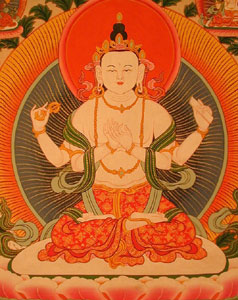This week, I discuss very briefly the last two forms of transmission, energy wave (བྱིན་བརླབས་) and permission (རྗེས་གནང་).
For the first, there seems to be very little distinction between an energy wave transmission and a great empowerment. Both are for major deities and involve the same basic elements. The energy wave transmission is a less elaborate ritual and may have developed when original Indian tantras were unavailable.
The second, permission, is by far the most common form of transmission. Most of what are called empowerments fall into this category and formal permission is a central part of both energy wave and great empowerment transmissions.
In permission transmission, you are formally introduced to the deity.

Why the formal introduction? Take Chenrezi, the embodiment of awakened compassion, for instance. Anybody who has had any contact with Tibetan Buddhism will have some contact with the four-armed form of Chenrezi and his mantra om mani padme hung. There is no reason why someone who is inspired by the ideal of universal compassion shouldn’t imagine him- or herself as Chenrezi and recite the mantra. And it is quite possible that such a practice will be profoundly beneficial in terms of that person’s spiritual development. People in all ages have discovered the possibility of such compassion in themselves, a phenomenon that calls into question one of the core assumptions of the insistence on transmission, namely, that what was once discovered can never be discovered again.
However, transmission can and does make a difference. The purpose of transmission is to plant a seed of experience in the student. In the case of the permission ceremonies, in addition to the energetic transmission that may take place when teacher and student practice together, transmission also takes place in the formal introduction. As my teacher explained to me, it is one thing to meet a person on your own, introduce yourself and get to know him or her one way or another on your own. It’s another for a person who knows that person well to introduce you, explain who the person is, what he or she is capable of, and how the two of you might interact fruitfully. The formal introduction not only establishes a different level of confidence, it also establishes the basis of the relationship and how it works.
Remember, in vajrayana, the deity is not the form of the deity. It is the principle of awakening that the deity embodies. For Chenrezi, the principle is awakened compassion; for Hevajra, awakened wrath; for Vajrapani, awakened power, etc.
The seed of experience planted in the empowerment ritual is then nurtured through regular practice. In turn, individual practice is made possible by two other transmissions, spoken transmission (ལུང་), which consists of the transmission of the texts associated with that practice that I discussed in an earlier newsletter, and instruction (ཁྲིད་), which consists of the actual practice instructions. In Tibetan, there is a saying which summarizes the roles of the various transmissions: the empowerment that matures, the spoken transmission that supports and the instructions that free.
As this saying makes clear, empowerment is simply the beginning of the process. What frees us from the vicissitudes of ordinary existence is the growth and blossoming of the seed planted in us. Where the empowerment ceremony is the seed empowerment and the practice ritual the path empowerment, the true empowerment takes place in the fruition of practice, when we experience the four mysteries directly:
- the mystery of sensory sensations arising as emptiness- appearance,
- the mystery of communication arising as emptiness-clarity,
- the mystery of thought and emotion arising as emptiness-awareness
- the great mystery of awareness itself, the utter groundlessness of all experience.
